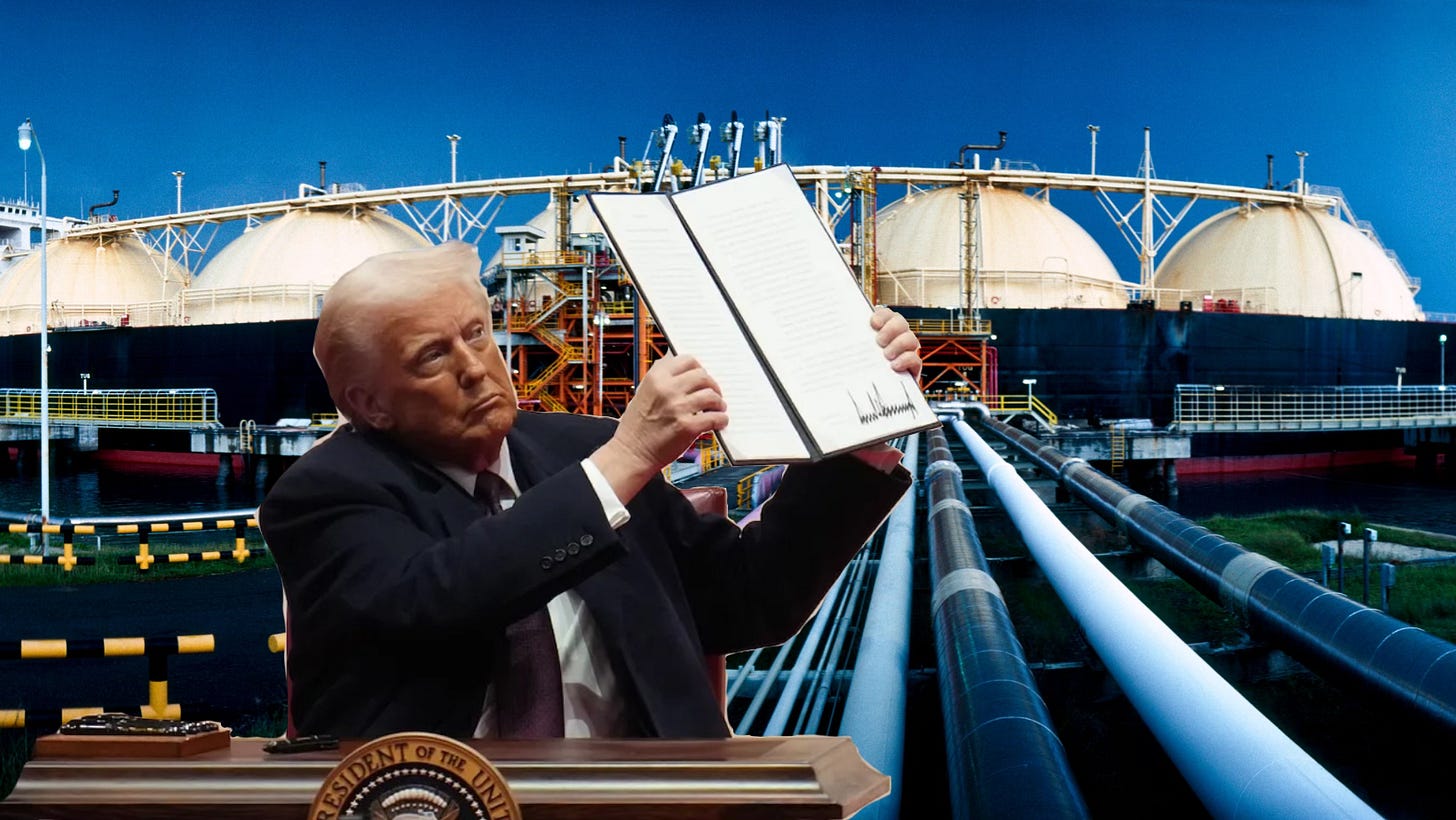Trump 2.0’s Executive Orders: More, Faster, Somehow
The energy Executive Orders warrant cautious optimism
I have some long-term-oriented posts chambered, but Donald Trump’s day-one Executive Orders (EOs) deserve one last Trump 2.0 post before I sit down and focus.1 Per my expertise (and my Roman-Empire fascination with American institutional collapse and restructure), I’m focusing on Trump’s executive actions related to energy (and thus climate) policy, and on organizational structure (including DOGE).
One thing to note up front is that no one in the Trump White House wrote these EOs—because there wasn’t a Trump White House yet. These documents were drafted, proofread, and confirmed for primetime before the inauguration, and they’re far too polished to come off Trump’s Truth Social feed. These EOs were written by Trump’s staff. This matters, because the staff will outlive Trump. The staff will define what Trumpism looks like in 2028.
The National Energy Emergency
Biden’s lame-duck period had the distinct energy of an army razing its own fortress in anticipation of a charging enemy they know will take the position. The Department of Energy in particular released a whitepaper defending the Biden Administration’s pause on LNG export terminals and (from personal experience) ran a fire sale of IIJA and IRA grant dollars in full anticipation of Trump revoking whatever was uncommitted. The White House, meanwhile, sent up a 2035 climate target that has already been 404’d from the whitehouse.gov site and issued a ban on offshore fossil drilling on Federal waters.
It was…pathetic, frankly. Sore loser energy. Dishonorable, even.
And like everyone expected, Trump’s initial Executive Orders walked all that stuff back. In particular, Trump’s EOs focus on fast-tracking permitting for a wide-ranging account of what “energy” means:
Crude oil, natural gas, lease condensates, natural gas liquids, refined petroleum products, uranium, coal, biofuels, geothermal heat, the kinetic movement of flowing water, and critical minerals. (Declaring a National Energy Emergency)
Notionally, the Trump team isn’t picky about energy types—they’re okay with solar, with storage, with hydroelectric generation. They just want more at every stage: “Identification, leasing, development, production, transportation, refining, and generation capacity.” The team asks regulatory agencies to consider options to “rescind, revoke, revise, amend, defer, or grant exemptions from any and all regulations, orders, guidance documents, policies, and any other similar agency actions,” to cut red tape the quick-and-dirty way: turning a blind eye. If an action requires emergency provisions, the President grants them. If it needs the Army Corps of Engineers, the hotline is provided. If the agencies have any recommendations for Congress, they are to get them to the White House in sixty days.2 This, notably, includes critical mineral supply chains—lithium, rare earths, copper, steel.
The Trump team wants the US Government to think differently about energy projects: less talk about carbon emissions and climate impact, more talk about economic, employment, and geopolitical impacts.3 To this end, one EO calls out an Alaskan pipeline project that would move natural gas from offshore plays in the Arctic to a proposed Pacific-facing LNG terminal “near” Anchorage. Japan and South Korea would be happy to see it materialize.
There are three core targets to the President’s ire:
Biden-era environmental policy
The National Environmental Policy Act (NEPA)
State policies in “our Nation’s Northeast and West Coast”
Biden’s environmental policies are handled as expected. All his environmental EOs are summarily rescinded. Unspent dollars from the Inflation Reduction Act (IRA) and the Infrastructure Investment and Jobs Act (IIJA) are frozen, and dollars toward EV charger infrastructure are mentioned in particular. The LNG export permitting freeze is lifted, and federal agencies are instructed to stop talking about the social cost of carbon.
The NEPA, being a work of Congress, is a bigger beast. The best the Trump team can do is demand recommendations on reform of NEPA and miscellaneous permitting and environmental regulations. Thomas Hochman is celebrating, because this EO wave includes revoking a Carter-era executive order empowering the Council of Environmental Quality (CEQ) to write NEPA regulations. This doctrine was already threatened by a DC Circuit ruling, but Trump’s executive action solidifies that reversal. Hochman notes that the Trump team requires CEQ and affected agencies to figure out a new regulation strategy prioritizing speed, efficiency, and “certainty.” More can be done, should Congress stop soiling itself enough to pass legislation. The Republican majorities in Congress have not given me hope in this respect.
As for state policies, Trump’s team particularly targets local bans on internal-combustion vehicles and limitations on pipeline infrastructure. This hits close to home—as I write this, New England is relying disproportionately on oil electric generation because of limitations on gas pipeline throughput.
This, for the most part, looks pretty good.
But I Have Three Worries
My vote for strangest Trump Executive Order is the withdrawal of offshore wind leasing options. The EO also asks the Interior Secretary and Attorney General to look for ways to kill live wind leases through the very environmental review processes that the Trump team wants to circumvent for literally every other type of energy. It smacks of “regulatory leeway for me and not for thee.” Why not unleash offshore wind and offshore oil and gas? If we’re already waiving environmental review in the name of a “national energy emergency,” why stop at offshore wind?
Related to that energy emergency, I fear that the Trump team doesn’t know where the bottlenecks are. Oil and gas production are not supply-constrained. In fact, national hub prices for hydrocarbons are at “we-ain’t-got-margin” lows. The limitations are in:
Natural gas pipelines from shale fields (where producers are flaring excess “associated gas” they can’t send elsewhere) to transmission-constrained areas like New England.
Electricity generation, transmission, and distribution. Not only is there insufficient infrastructure to meet electricity demand coming in the next 10-25 years, but there’s also insufficient industrial capacity to build enough domestic solar panels, batteries, generation turbines, electrical steel, transformers, etc.
I don’t think anyone in the Trump camp is talking about electricity transmission and distribution. Even if decarbonization is a purported scam, all the new housing and manufacturing and AI capacity Trump asked for needs more electricity. We have enough hydrocarbon production.
And finally, I have to ask…how is the President going to do this? It’s all well and good to tell executive agencies to search under the couch cushions for permitting exceptions, but does the Trump White House plan to deploy GBU-54 Laser JDAM dual-mode precision-guided bombs toward Sierra Club offices? Environmental activist groups will point litigation at every aspect of the Trump energy agenda, and the American judiciary has gotten quite comfortable making policy on its own. Until Congress acts, the Trump White House can only go so far in reducing regulatory and administrative burden.
Putting The Federal Government on a PIP
Trump’s Executive Orders related to hiring and firing are liable to be his most consequential and long-lasting impact on the United States Government—if they stick. The biggest letdown is the implementation of the Department of Government Efficiency (DOGE). It’s instituted as a mere rebrand of the US Digital Service—now the US DOGE Service—with the limited mandate of “modernizing Federal technology and software to maximize governmental efficiency and productivity.” This will entail an administrator reporting to the Chief of Staff and a four-person team in each Agency to push a Jennifer Pahlka-type beat.4 Tepid.
The bigger fish are in hiring-and-firing policy in general—setting a government-wide time-to-hire target of 80 days, asking for improved communication with candidates, requiring “regular updates on the progress of applications and explanations of hiring decisions,” and pushing for digitization (and DOGE input) in the hiring practice. Notably, the Trump team wants political appointees to have more input in hiring as well—bad if you’re a cargo cult Democrat, good if you want to shake off old-growth staff.
And Trump wants to shake off old-growth staff. The “Schedule F” doctrine returns—now renamed Policy/Career staff—with its goal of bypassing standard hiring and firing practice in federal positions. This is probably good—my understanding is that most federal positions are not “at-will,” which allows a lot of people to keep government jobs at a level of competence below what would fly in the private sector. Meanwhile, all staff at the Senior Executive Service level are placed on an immediate performance improvement plan (PIP), with their existing Executive Resources and Performance Review Boards dissolved and reconstituted.5
In the moment, this reads like making more of the federal government hire and fire like the private sector—and Congress could assist this by making the federal government pay like the private sector. Right now, Senior Executive Service pay is bounded between $150k and $225k/year, whereas an equivalent ITC6 (Apple), L7 (Netflix/Google), or E7 (Meta) is making $600k-800k/year.
A New Institutional Model
Thomas Friedman’s The Storm Before the Calm frames this current time period as the tipping point towards the fourth institutional cycle in the United States. The first tipping point (the Revolutionary War) established the American colonies as a nation of sorts. The second (the Civil War) established Washington, DC as holding real power over these the United States. The third (the Second World War) established the federal government’s control over daily life and economic activity. And this fourth tipping point will re-evaluate the federal government’s relationship to itself.
Since the Second World War, the United States government has comprised technocrats—nonpartisan experts—operating in the Taylorist doctrine of empirical analysis, standardization, and having a designated form for everything. Since Reagan (since his predecessor Carter, really), we’ve expanded that technocratic ideal to military affairs, economic policy, and permitting doctrine.
The American public fell out of love with experts a decade ago—hence Trump’s first election. But now elite political thought has converged against those experts as well. Elon Musk’s policy of “the best part is no part” is coming to the White House as “the best form is no form.” Anduril’s manifesto to “rebuild the arsenal,” a move against hyper-managed procurement processes and “exquisite” machinery, is becoming a real factory in Ohio. Trump’s “national energy emergency” is a clarion call to apply “move fast and break things” towards environmental and energy policy.
I’m Cautiously Optimistic
I think Trump has a shot at success. These Executive Orders—for the most part—target the right issues in energy policy and might motivate necessary organizational change in the federal government. There’s other stuff in the day-one documentation, and a lot of room for disaster, but frankly I don’t care that much.
Let’s be real—New England is a cultural and economic backwater now. Little of the coming decade’s growth in energy infrastructure, AI development, manufacturing, or political dynamism is going to the enclave of Puritan snobs and our respective ski resorts.6 Sure, Trump 2.0 might kill our offshore wind ambitions, but the Ack Rats were already on the case. We will continue our climate goals in defiance of Washington, we will continue to implement gas stove bans and Clean Heat Standards, and we will continue buying solar systems and electric vehicles out of principle. We have our share of Trump voters, but they will remain distant from our state capitals and out-of-sync with the vicissitudes of the increasingly forward-looking, tech-influenced White House. The Black Audis of Beacon Hill will retain control. And my friends will stay safe.
This gives me insurance. New England will stick to the devil we know—a devil whose rent I can personally afford—while the rest of the country flirts with an uncertain future. Unless my employer finds this blog and determines it a terminable offense, I can sit pretty at my Notion dashboard and observe whether Trump can follow through on the change he promises. Whether he succeeds or fails, I’ll have an angle once the dust settles.
In the meantime, I have my road bikes and my boutique espresso.
This post and the information presented are intended for informational purposes only. The views expressed herein are the author’s alone and do not reflect those of their current or previous employers or any elected officials. The author makes no recommendations toward any electric utility, regulatory body, or other organization. While certain information contained herein has been obtained from sources believed to be reliable, the author has not independently verified this information, and its accuracy and completeness cannot be guaranteed. Accordingly, no representation or warranty, express or implied, is made as to, and no reliance should be placed on, the fairness, accuracy, timeliness or completeness of this information. The author assumes no liability for this information and no obligation to update the information or analysis contained herein in the future.
For a broader perspective on my expectations of Trump 2.0, here are my 2025 predictions: both the narrative and quantitative versions.
2025 Energy Predictions: Narrative Edition
Last week, I made some bets on the 2025 energy map for fun and accountability. But those bets were quantitative in structure, justification, and evaluation—and I’m fundamentally a qualitative analyst, a wannabe English major who took up engineering for career purposes.
This entails that I look for these reports at the end of March. Remind me if I forget.
Pahlka helped found the US Digital Service in the first place!
Interestingly, the Senior Executive Service structure was—like CEQ—also instituted under Jimmy Carter.
The only exceptions are a series of enclaves between Kendall Square, Harvard Square, and Union Square. But I was only invited to the Greentown parties.





If you had to guess who did draw up the EO, who would it be? The strange outlawing of wind energy makes it seem like it had to be oil and gas lobbyists.